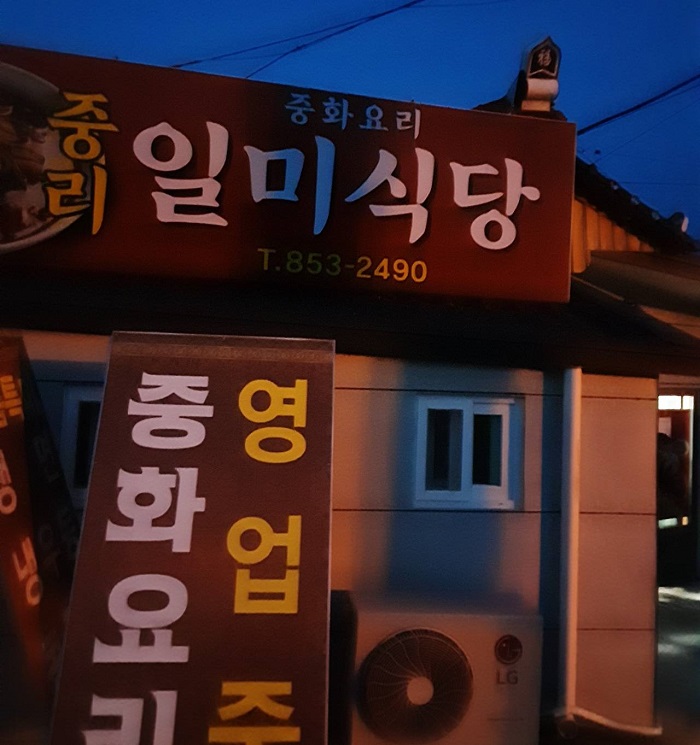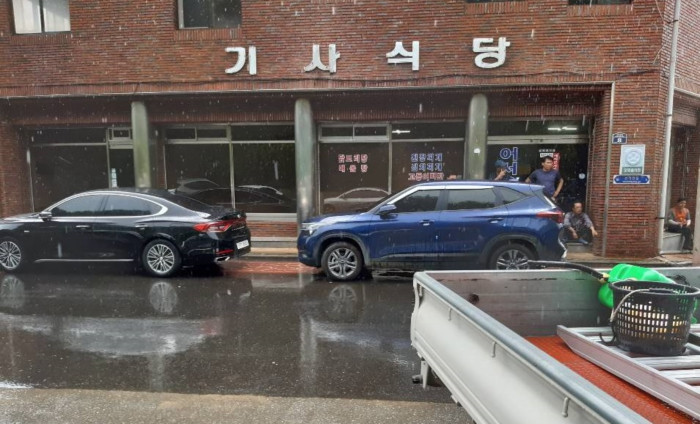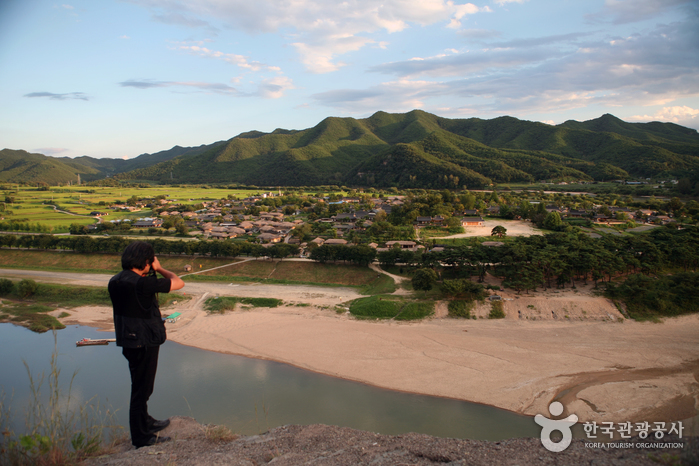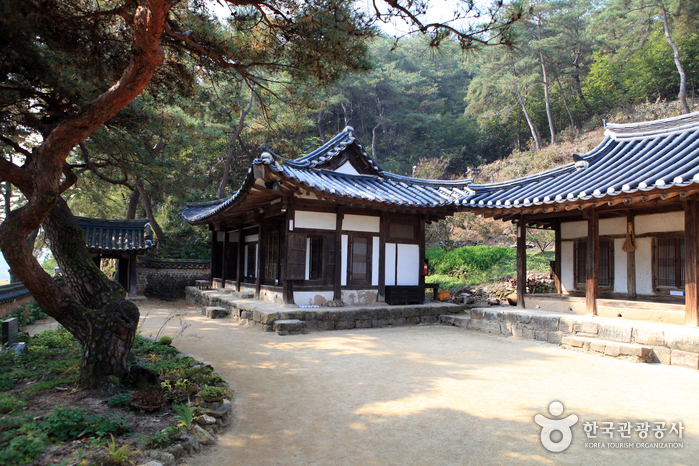Yekki Maeul (예끼마을)
17.5Km 2024-07-08
14, Seonseong-gil, Dosan-myeon, Andong-si, Gyeongsangbuk-do
Le village Yekki est un village artistique à Andong. Les alllées du villages sont décorées avec des peintures murales réalisées par des artistes locaux. Le principal charme du village est le chemin de l'eau Sunseong Susang-gil, un chemin de promenade sur l'eau.
Ilmi Sikdang (일미식당)
17.5Km 2021-03-24
1672, Jipung-ro, Andong-si, Gyeongsangbuk-do
+82-54-853-2490
This is a place that is visited frequently by Andong citizens. This Chinese (cuisine) restaurant is located in Andong-si, Gyeongsangbuk-do. The most famous menu is noodles in black bean sauce.
Imhaho Gisa Sikdang(임하호기사님식당)
17.6Km 2021-04-09
8, Seonchakjang-gil, Andong-si, Gyeongsangbuk-do
+82-54-822-4929
There are a variety of side dishes, so you can enjoy different foods. This Korean dishes restaurant is located in Andong-si, Gyeongsangbuk-do. The representative menu is kimchi stew.
Spectacle de la danse des masques, Hahoe Byeolsingut Tallori (하회별신굿탈놀이 상설공연)
17.6Km 2020-04-28
3-15, Hahoejongga-gil, Andong-si, Gyeongsangbuk-do
- Ligne Info Tourisme : +82-54-1330 (anglais, japonais, chinois)
- Pour obtenir plus d'info : +82-54-854-3664 (anglais)
Le Byeolsingut Tallori du village de Hahoe a été désigné comme patrimoine culturel intangible numéro 69. Il est joué depuis près de huit cents ans et se compose de 12 actes de danses dynamiques incluant des parties chantées ou parlées faisant la satire de moines corrompus et de nobles déchus. De façon plus générale, cette danse des masques évoque les relations entre classes dominantes et dominées à travers les joies et les peines de personnages représentatifs du peuple, soulignant les irrationnalités de la société de l’époque. La diversité des masques et la mise en scène ajoute un intérêt supplémentaire à ce spectacle d’une durée d’une heure environ.
Suaedang [Korea Quality] / 안동 수애당 [한국관광 품질인증]
18.0Km 2023-04-13
1714-11, Sugogyonggye-ro Imdong-myeon, Andong-si, Gyeongsangbuk-do
+82-54-822-6661
'Suaedang Traditional House was built by Ryu Jin-geol, also known by his pen-name of Suae, in 1939. This hanok-style house consists of three buildings that measure 29-kan (a traditional measurement that corresponds to the space between two columns) in total.
The main room, or jeongchim (7-kan at front and 2-kan at sides), has a half-hipped roof, and forms a‘ㄱ’-shape with the storeroom (10-kan at front), which also has a half-hipped roof. Originally located at 612 Sugok-dong, Andong-si, the house was relocated from a slight slope to a flat piece of land due to the construction of Imha Dam in 1987. Consequently, the Jeongchim was rebuilt at a lower level than before.
The Suaedang was renovated by modernizing the old-style facilities including the kitchen, toilets, and washroom without changing their external features, while the rooms and daecheongmaru (main floored room) were decorated with red clay and natural paint. Suaedang, with its beautiful panoramic view of the lake, was designated as Gyeongsangbuk-do Cultural Property No. 56.
Falaise de Buyongdae (부용대)
18.2Km 2021-05-25
72, Gwangdeoksolbat-gil, Pungcheon-myeon, Andong-si, Gyeongsangbuk-do
+82-54-852-6800
La falaise de Buyongdae mesure 64 mètres de haut et se situe à l’extrêmité de la chaîne de montagnes Taebaek. Le sommet offre une vue panoramique du village de Hahoe à Andong. Son nom vient d’une ancienne histoire chinoise. Le nom de Buyongdae, qui signifie lotus, lui aurait été donné à cause de la configuration du village de Hahoe en forme de fleur de lotus. Par conséquant, c’est depuis la falaise que l’on a la meilleure vue de Hahoe. A proximité de Buyongdae se trouve la maisone de Ogyeonjeongsa, la maison de Gyeomamjeongsa et l’académie de Hwacheon Seowon.
Maison Ogyeonjeongsa (하회옥연정사)
18.2Km 2017-05-24
86, Gwangdeoksolbat-gil, Pungcheon-myeon, Andong-si, Gyeongsangbuk-do
La Maison Ogyeonjeongsa, située au pied de la falaise Buyongdae dans le village de Hahoe à Andong, a été construite par Ryu Seong-yong, qui fut ministre durant la période Joseon. Sa construction a débuté en 1576 (9ème année du règne du roi Seonjo) et s’est achevée en 1586 (19ème année du règne du roi Seonjo). C’est dans cette maison que furent écrites les mémoires de guerre « Jingbirok » après l’Imjinwaeran, l’invasion de la Corée par le Japon en 1592. Pour vous rendre à la maison Ogyeonjeongsa, il vous faut traverser la rivière en ferry. En dépit de l’apparence modeste de la demeure, la beauté sans prétention de cette maison coréenne se fond parfaitement dans le magnifique cadre naturel des falaises, de la rivière et de la forêt.
* Ecole Sesimjae
Cette école privée est dotée en son centre d’un plancher en bois Gamrokheon, flanqué de chambres de chaque côté.
* Maison Wolnakjae
Wolnakjae signfie « attendre un ami ». C’est dans cette maison que le ministre Ryu Seong-yong a écrit ses mémoires de guerre Jingbirok.
* Centre d’activités
Sesimjae (deux chambres de quatre personnes maximum chacune, plancher en bois Gamrokheon)
Wolnakjae (une chambre pour huit personnes maximum, plancher en bois Aeoheon)
Okyeon pavilion [Korea Quality] / 옥연정사 [한국관광 품질인증]
18.2Km 2023-04-13
86, Gwangdeoksolbat-gil Pungcheon-myeon, Andong-si, Gyeongsangbuk-do
+82-54-854-2202 / +82-10-4520-3640
Ogyeonjeongsa House was established by Ryu Seong-yong (pen-name: Seoae, 1542-1607), a minister of Joseon, with the help of Buddhist monk Tanhong, as a place to study and educate his students. After building Wonjijeongsa House, Ryu wanted to build another house at the foot of Buyongdae Cliff amid a tranquil environment away from the village, but due to his financial situation he was unable to complete the building by himself. Then, the monk Tanhong helped him build Ogyeonjeongsa House, which took ten years (1576 to 1586) to complete, when Ryu was 45 years old. Later, Ryu Seong-yong was able to share warmth with his brother (Gyeomam), who lived in nearby Gyeomamjeongsa House. Ryu later lost his house in Hahoe in the great flood of the Nakdonggang River in 1605, and retired to Ogyeongjeongsa House where he wrote Jingbirok (The Book of Correction, National Treasure 132), a memoir of the Imjin War (Japanese Invasion of Korea in 1592). The house’s guestrooms include Sesimjae (meaning ‘having a mind to this place to achieve at least one in ten thousand things,’ inspired by the I Ching or The Book of Changes), which was used by Ryu as a schoolhouse and has two small rooms between the maru gamheonrok (wooden floor, meaning ‘looking up at the sky and down at the blue water,’ inspired by Wang Xizhi’s poetic diction); Wonlakjae (meaning ‘waiting for a friend’s visit,’ inspired by the Analects of Confucius), in which Ryu himself resided and wrote Jingbirok; and the maru aeoheon (meaning ‘I also love my hut,’ taken from a poem by Chinese poet Tao Yuanming), which measures two kan (a unit of measurement referring to the distance between two columns).
Bukchondeak [Korea Quality] / 하회 북촌댁 [한국관광 품질인증]
18.2Km 2020-09-08
7, Hahoebukchon-gil, Pungcheon-myeon, Andong-si, Gyeongsangbuk-do
+82-54-853-2110, +82-10-2228-1786
Located in Hahoe-ri (Pungcheon-myeon, Andong-si, Gyeongsangbuk-do), Hahoe Bukchondaek House is a hanok stay that was originally built by a civil official named Ryu Sa-chun in 1797 (the 21st year of the reign of King Jeongjo of the Joseon dynasty). It consists of a small sarangchae (men’s quarters) with two wing buildings at sides. As the anchae (women’s quarters), large sarang, daemungan (gate building), and shrine were built by Ryu’s great-grandson, Ryu Do-seong (who served as a governor of Gyeongsang-do), in 1862 (the 13th year of the reign of King Cheoljong), the house displays the typical features of a Joseon nobleman’s house and is the largest in Hahoe. The large sarangbang, Bukchonyugeo (measuring 7-kan* at the front, 3-kan at the sides), consists of two 2-kan rooms, two 1-kan rooms, a 4-kan daecheong (wooden floor), a 3-kan numaru (upper floor), a 3-kan kitchen, a 3-kan garret, a 5-kan toe (the narrow wooden veranda running along the outside of the building), and a jjokmaru (narrow wooden veranda). The entire building can be converted into a single space simply by opening the sliding doors between the rooms and the doors between the rooms and the daecheong. The medium-sized sarang, Hwagyeongdang, consists of a 2-kan room, a 1-kan daecheong, a 3-kan toe, and a jjokmaru, while the small sarang, Susinwa, consists of a 1-kan room, a 1-kan daecheong, and a 2-kan toe. The anchae has a courtyard in the middle, a kitchen, a main room, a daecheong, a gobang (storeroom), a witsangbang (upper room), a toenmaru (a narrow wooden porch running along the outside of the building), an araetsangbang, a jungmun that links to the large sarang, an araetgwang (storeroom), a dwiju (grain-chest), and a munganbang (gate building room). The munganchae (gate building) and shrine are also situated within the grounds of the house, along with a 300-year-old pine tree that is known for its curved shape, which is said to resemble the Nakdonggang River as it meanders around the village of Hahoe. The house contains valuable cultural heritages including Doseongpaldojido (Map of the Eight Provinces of Korea), which is estimated to date from the seventeenth century, and is regarded as an invaluable historic material as it includes Dokdo Island and Jiandao as part of the Korean territory, and a painting titled ‘Sehwa,’ which is believed to have been given to Ryu Yi-jwa (pen-name: Hakseo, 1763-1837) by the king as a New Year’s present. Bukchondaek House was built by one of the richest families in Hahoe, who are well known for their generosity as they have helped local people on many occasions throughout history. *kan: a unit of measurement referring to the distance between two columns.
RakKoJae Andong(Hahoe) [Korea Quality] / 락고재 안동(하회) [한국관광 품질인증]
18.3Km 2023-04-13
51, Hahoegangbyeon-gil, Pungcheon-myeon, Andong-si, Gyeongsangbuk-do
+82-54-857-3410
Rakkojae, meaning “a place where one can enjoy ancient traditions and rest one’s soul”, is located near the beautiful ferry on the Nakdonggang River in Hahoe, Andong. After passing by a pine tree decorated with traditional Korean lanterns and entering the cozy courtyard, visitors will find four well-maintained houses with thatched-roofs made with local rice straw. As Rakkojae is some way from the Hahoe Village, and is adjacent to the Nakdonggang River, guests can enjoy walking along the ferry and the walkway while appreciating the beautiful scenery of the river and Buyongdae Cliff with its serene atmosphere. Rakkojae has three guest accommodations – the anchae at the front, the sarangchae and the byeolchae on the sides, and the munganchae. While the anchae has two rooms, a kitchen and a daecheong (main floored room), both the sarangchae and the byeolchae consist of a daecheong and one room. The maximum number of guests per room is ten so that guests can enjoy their stay with ease. Each room is decorated with hanji (traditional Korean paper handmade from mulberry trees) and features a simple built-in closet, ceiling-type air conditioning, and a modern bathroom with a toilet and a bathtub made of Hinoki cypress. In particular, the munganchae has a red clay jjimjilbang (Korean dry sauna) supplied with mugwort that is popular among both domestic and foreign guests. Guests often enjoy relaxing at Rakkojae by appreciating the sunshine and breeze while lying on the daecheong floor, walking barefoot on the earthen ground, and drinking makgeolli (unrefined rice wine)among other activities. The owners of Rakkojae hope that it will be a place where guests can heal their tired body and mind and experience the true atmosphere of Korea. The Pine Wood of Mansongjeong Pavilion (Natural Monument No. 473) situated next to Rakkojae is also a good place for a stroll. Furthermore, the hotel serves a hearty breakfast consisting of heotjesatbap (Andong-style bibimbap with soy sauce) and salted grilled mackerel.



![Suaedang [Korea Quality] / 안동 수애당 [한국관광 품질인증]](http://tong.visitkorea.or.kr/cms/resource/88/2528888_image2_1.jpg)


![Okyeon pavilion [Korea Quality] / 옥연정사 [한국관광 품질인증]](http://tong.visitkorea.or.kr/cms/resource/50/2578050_image2_1.jpg)
![Bukchondeak [Korea Quality] / 하회 북촌댁 [한국관광 품질인증]](http://tong.visitkorea.or.kr/cms/resource/74/2626274_image2_1.jpg)
![RakKoJae Andong(Hahoe) [Korea Quality] / 락고재 안동(하회) [한국관광 품질인증]](http://tong.visitkorea.or.kr/cms/resource/84/2573784_image2_1.jpg)
 Français
Français
 한국어
한국어 English
English 日本語
日本語 中文(简体)
中文(简体) Deutsch
Deutsch Español
Español Русский
Русский